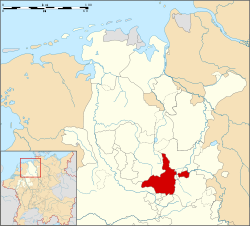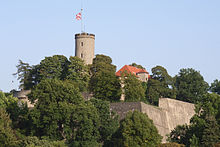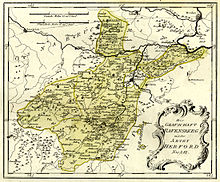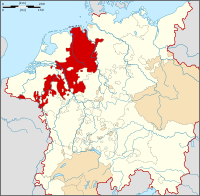- County of Ravensberg
-
For the city in Baden-Württemberg, see Ravensburg.
County of Ravensberg
Grafschaft RavensbergState of the Holy Roman Empire (until 1806) ← 
1140s – 1807  →
→Coat of arms
Map of part of the Lower Rhenish–Westphalian Circle in
1560, County of Ravensberg highlighted in redCapital Bielefeld Government Principality Historical era Middle Ages - Otto I, Count of
Ravensberg
1140s 1140s- Gerhard I, Count of Berg
and Ravensberg
1338- Joined Westphalian
Imperial Circle
1500- John III, Duke of
Jülich-Cleves-Berg
1521- To Brandenburg-Prussia
by Treaty of Xanten
1614- Disestablished 1807 The County of Ravensberg (German: Grafschaft Ravensberg) was a historical county of the Holy Roman Empire. Its territory was in present-day eastern Westphalia, Germany at the foot of the Osning or Teutoburg Forest.
Contents
History
Ravensberg was first mentioned in the 12th century; its first capital was Burg Ravensberg. The Counts of Ravensberg then had Sparrenberg Castle built in Bielefeld ca. 1240–50, which they made their seat.
The county was later inherited by the Duchy of Berg in 1346, which in turn became part of the Duchy of Jülich-Berg in 1423, and ultimately the United Duchies of Jülich-Cleves-Berg in 1521.
After the War of the Jülich succession, in the Treaty of Xanten in 1614, the County of Ravensberg came to the Margraviate of Brandenburg, which became the Kingdom of Prussia in 1701, and was administered within Minden-Ravensberg from 1719–1807, when it was dissolved during the Napoleonic Wars.
Aside from Bielefeld, other communities in the County of Ravensberg were Borgholzhausen, Halle, Steinhagen, Versmold, Werther, Isselhorst (now part of Gütersloh), Enger, Hiddenhausen, Rödinghausen, Spenge, Herford (except for Falkendiek), Bünde (except for Dünne and Spradow), Vlotho (except for Uffeln), Kirchlengern south of the Werre, Preußisch Oldendorf (except for Hedem and Lashorst) and Bad Oeynhausen south of the Werre.
Rulers
House Calvelage-Ravensberg
- Until 1144 Hermann I
- ca.1140 -ca.1170 Otto I
- ca.1160 -ca.1180 Heinrich
- ca.1175 -ca.1220 Hermann II
- ca.1220 -1244 Otto II
- ca.1220 -1249 Ludwig
- 1249-1306 Otto III
- 1306-1328 Otto IV
- 1328-1346 Bernard
House of Jülich
1348-1395 in Personal union with Berg, since 1437 with Jülich-Berg
- 1346-1360 Gerhard I
- 1360-1408 William I, lets his 2 sons rule :
- 1395-1403 Adolf
- 1403-1428 William II
- 1428–1475 Gerhard II
- 1475–1511 William III
House of La Marck, Dukes
– from 1521 a part of the United Duchies of Jülich-Cleves-Berg –
- 1511–1539 John
- 1539–1592 William V
- 1592–1609 John William I
House of Hohenzollern
- from 1614 Margraves of Brandenburg and Kings of Prussia -
- 1614–1619 John Sigismund of Hohenzollern
- 1619–1640 George William, son
- 1640–1688 Frederick William I, son
- 1688–1713 Frederick I, son, King in Prussia from 1701
- 1713–1740 Frederick William I, son, King in Prussia
- 1740–1786 Frederick II, son, King of Prussia from 1772
- 1786–1797 Frederick William II, nephew, King of Prussia
- 1797–1807 Frederick William III, King of Prussia
To France by the 1807 Treaty of Tilsit, incorporated into the Kingdom of Westphalia
See also
External links
 Media related to County of Ravensberg at Wikimedia Commons
Media related to County of Ravensberg at Wikimedia Commons Lower Rhenish–Westphalian Circle (1500–1806) of the Holy Roman Empire
Lower Rhenish–Westphalian Circle (1500–1806) of the Holy Roman EmpireEcclesiastical Prelates Secular Counts
and lordsfrom 1500Bentheim · Bronkhorst (until 1719) · Diepholz · East Frisia (until 1667) · Horne3 (until 1614) · Hoya · Lingen3 · Lippe · Manderscheid (until 1546) · Moers (until 1541) · Nassau (Diez · Hadamar · Dillenburg (until 1664)) · Oldenburg (until 1777) · Pyrmont · Ravensberg3 · Reichenstein · Rietberg · Salm-Reifferscheid · Sayn · Schaumburg · Tecklenburg · Virneburg · Wied · Winneburg and Beilstein · Zimerauff?from 1792Anholt · Blankenheim and Gerolstein · Gemen · Gimborn · Gronsfeld · Hallermund · Holzapfel · Kerpen-Lommersum · Myllendonk · Reckheim · Schleiden · Wickrath · Wittemstatus
uncertainCities 1 from 1792. 2 until 1792. 3 without Reichstag seat. ? status uncertain.Territories and provinces of Prussia (1525–1947) Before 1701 Duchy of Prussia · Margraviate of Brandenburg · Cleves / Mark / Ravensberg (1614) · Farther Pomerania / Minden / Halberstadt (1648) · Lauenburg–Bütow / Draheim (1657) · Magdeburg (1680) · Colonies (Groß Friedrichsburg · Arguin)After 1701 Neuchâtel (1707) · Guelders (1713) · Minden-Ravensberg (1719) · Western Pomerania (1720, 1815) · Silesia / Glatz (1742) · East Frisia (1744) · East / West Prussia (1772-73) · South Prussia (1793) · New East Prussia / New Silesia (1795)Post-Congress of
Vienna (1814–15)Brandenburg · Pomerania · Grand Duchy of Posen1 · Saxony · Silesia · Westphalia · Rhine Province2 (1822) · Province of Prussia (1824–78) · Hohenzollern (1850) · Schleswig-Holstein / Hanover / Hesse-Nassau (1866–68)Territorial reforms
after 1918Lower / Upper Silesia (1919) · Greater Berlin (1920) · Posen-West Prussia (1922) ·
Halle-Merseburg / Magdeburg / Kurhessen / Nassau (1944)Coordinates: 52°05′31.79″N 8°34′14.55″E / 52.0921639°N 8.5707083°E
Categories:- Former principalities
- Former countries in Europe
- States of the Holy Roman Empire
- States and territories established in the 1140s
- States and territories disestablished in 1807
- 1807 disestablishments
- Subdivisions of Prussia
- History of North Rhine-Westphalia
- Lower Rhenish-Westphalian Circle
- Preußisch Oldendorf
Wikimedia Foundation. 2010.





